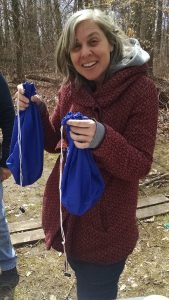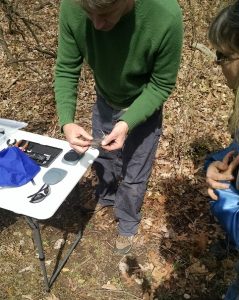Baltimore Green Space holds our first bird banding demonstration
By Molly McCullagh & Katie Lautar
Colin Studds’ research often takes him to the Caribbean to study migratory song birds that overwinter in Jamaica; this season, he’s more likely to be found in a forest patch in Baltimore City. One chilly Sunday, Baltimore Green Space hosted a bird banding to watch the research up close.
Throughout the spring and summer Colin Studds, UMBC professor and Smithsonian Institute migratory bird scientist, will be gathering wildlife data in Baltimore’s forest patches in partnership with Baltimore Green Space. Our goal is to understand the role of forest patches in supporting wildlife in Baltimore. To kick off the project, Baltimore Green Space and Colin conducted a mist netting and bird banding demonstration for 20 people. If you happened upon our group that chilly Sunday morning, you might have wondered what we were up to.
In the business of birding, waiting is part of the work. Most of the morning, we stood in a clearing in the woods and chatted, occasionally wandering close to a tree to identify it or bringing binoculars to our eyes to see something up high in the trees. It’s possible we could have been mistaken for a large family outing. (Our youngest participant, an award-winning birder, got a ride from her mom and then shooed her away!)

Birders observe Colin’s technique.
Glenda Weber of Cylburn Arboretum, who has 22 years of bird banding experience, claimed she was out of practice but she didn’t miss a beat, checking the nets for birds every 15 minutes. We had almost given up on catching birds when forest steward Sylvester Myers exclaimed, “We got one!” This morning, the reward for patience was the chance to hold and observe birds up close.
The purpose of the event was to take measurements of the birds’ wings, weight, and fat layer, and to attach bands to their legs. The bands are tiny, lightweight strips of metal with a tracking number assigned by the United States Geological Service (USGS). If the bird is caught again, its whereabouts can be reported, helping scientists recognize changes in migration activity from year to year.
Colin and Katie Lautar from Baltimore Green Space had arrived early to set up the bird banding nets. The nets are made of wide black mesh that virtually disappears when stretched out among the trees. Birds certainly don’t notice it, and will often get themselves gently tangled. The birders unwrapped them and placed them in cloth bags to carry them to the measuring station. The bags containing the birds were first placed on a scale to be weighed.
Colin then carefully removed each bird from the bag, with two fingers holding the bird’s legs still and two fingers around its body. Using small instruments, he measured wingspan and beak length. Holding the bird on its back, Colin blew onto the bird’s chest, ruffling its feathers so that he could get a look at its fat layer. This looks like a yellow bubble on its chest. The layer can indicate how healthy the bird is and if it is getting ready for a migratory flight, when food might be scarce. All of these measurements are recorded in a log that will be reported to the USGS.
We caught 11 birds in four hours, including a phoebe. Knowing the variety and health of birds found on one site is useful in itself, but even more interesting when coupled with data from multiple sites in Baltimore. By studying the types of birds that we encounter on a given day and tracking their movements from patch to patch, we can start to get a sense of how animals interact with their habitat and what size of patches are important to preserve. Stay tuned for this season’s data. To donate to our forest efforts, click here.

Katie holds bags containing
a bird to be measured.

Be the first to hear about exciting events, news, and opportunities.
[email protected]
(813) 530-8166
2100 Liberty Heights Avenue
Baltimore MD 21217
Facebook | Instagram | Twitter